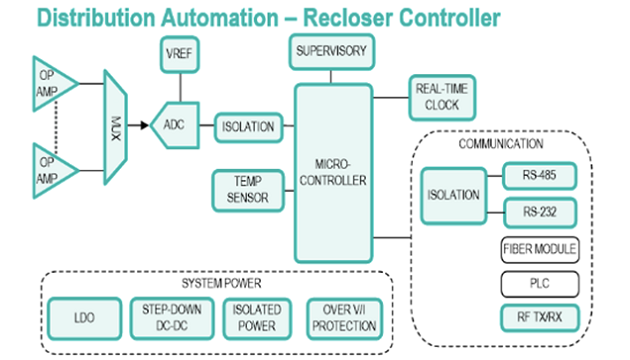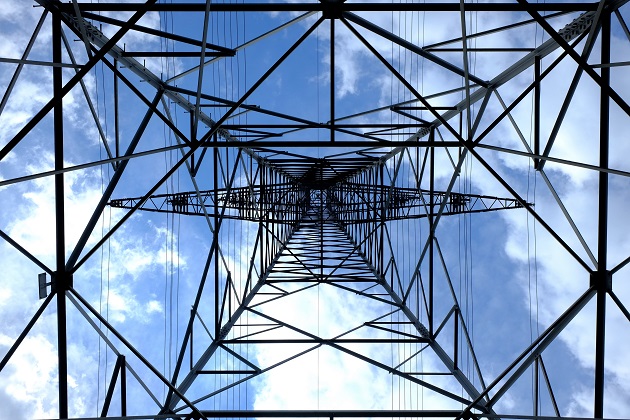A variety of freakish incidents can cause the lights to go out. A tree branch could fall across power lines, disrupting the electricity flow. A mylar balloon can get tangled up with the wires. A lightning strike can trigger darkness. To maintain service continuity, utility companies design recloser controllers into their overhead power distribution systems.
Recloser controllers, which sense the voltage and current of AC transmission on power lines, play an essential role by in smart grids by detecting and interrupting momentary faults. Short-circuits on overhead lines can resolve themselves. But in cases where this doesn’t happen, recloser controllers can automatically restore power in the event of a momentary fault. When there’s a power surge or fault, power relays open to contain the fault and also prevent cascading faults (when the fault spreads throughout the grid). Momentary faults such as those I’ve highlighted can cause lines to cross temporarily. Continuing to sense the powerline, the recloser controller attempts to close or reclose the relay if AC performance is stable. Once the relay is closed, if high voltages, currents, or other fault events are still detected, the relay opens again. Typically, a recloser attempts to reclose a relay three to five times. The beauty of this approach is that the grid works to heal itself, thus avoiding the need to have a technician come in to diagnose the problem.
What Makes a Good Recloser Controller?
Effective recloser controllers have several critical features:
- The powerline includes three voltages, three currents, one or two grounds, and, often, redundancy. Since recloser controllers sense the powerline, high accuracy is essential, especially for measurement of harmonics.
- Since recloser controllers must report events to the larger grid, communication is a critical capability. Most smart grids feature wireless or powerline communication networks. Units like recloser controllers typically maintain their legacy serial communication, such as RS-485, which gets translated into their wireless protocol of choice through a gateway or other hardware.
- Multiple power supplies, with both AC and DC inputs, are used. A battery is included in the system, since it must operate and sense the AC lines even when the power is out.
- Often applied upstream of the signal chain and again afterwards, isolation ensures reliable system operation and protection of the electronics. Isolation is also important prior to communication links, and a variety of isolation options is often ideal
Built with Analog ICs

The underlying technology for recloser controllers includes a variety of key analog building blocks. Figure 1 depicts a block diagram that offers an example of a recloser controller design. The diagram shows a variety of voltage monitoring, supervisory, system power, and communication circuits. To choose the right parts, consider the fact that characteristics like high accuracy, wide voltage protection range, low power dissipation, and small form factor are essential in recloser controllers. MAX16126/MAX16127 load-dump/reverse-voltage protection circuits offer an example of ICs that meet these characteristics. With a built-in charge pump, these ICs control two external back-to-back n-channel MOSFETs that turn off and isolate downstream power supplies during damaging input conditions. They include a flag output that signals during fault conditions. For reverse-voltage protection, external back-to-back MOSFETs minimize voltage drop and power dissipation during normal operation, outperforming traditional reverse-battery diodes. Another example of a reliable, low-power microprocessor supervisor is the MAX6365 family, which features battery backup and chip-enable gating. Available in miniature 8-pin SOT23 packages, the MAX6365 supervisory circuits simplify power-supply monitoring, battery-backup control functions, and memory write protection in microprocessor systems. For an always-on application like a recloser controller, the low-quiescent-current MAX6766 linear regulators offer a good option. Operating from 4V up to 72V, the MAX6766 regulators deliver up to 100mA of load current while consuming only 31µA of quiescent current.

Smart grids are making electricity delivery more efficient and reliable, while also bringing greater resiliency to the electric infrastructure. As you design your next recloser controller, keep in mind the characteristics and capabilities of their underlying technologies. It’s all part of keeping the power on.








